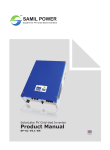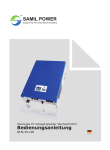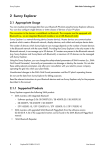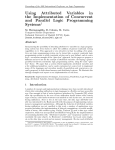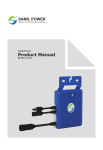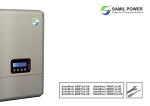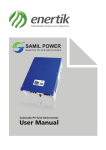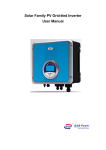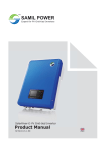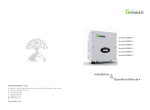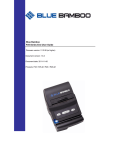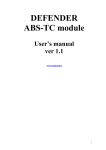Download SolarLake 10000TL-17000TL-Product Manual-V5-3_EN
Transcript
TM SAMIL POWER Expert for PV Grid-tied Inverters SolarLake Grid Connected Inverter Product Manual SP–SL–V5.3–EN English Copyright Declaration The copyright of this manual belongs to Samil Power Co., Ltd. Any Corporation or individual should not plagiarize, partially copy or fully copy this document (including software). This document should not be reproduced or distributed in any form or means. All rights reserved. Samil Power reserves the right of final interpretation. This manual is subject to change according to user or customer feedback, hence please check website www.samilpower.com for the latest version. 01 02 Contents 1 2 3 4 Basic safety information 7 1.1 Preface 7 1.2 General information 7 1.3 Safety instruction 7 1.4 Pre installation checks 8 1.5 Transport 8 1.6 Electric connection 8 1.7 Operation 8 1.8 Maintenance and repair 9 1.9 EMC / noise level of inverter 9 Product description 10 2.1 Function 10 2.2 Electrical block diagram 10 2.3 Dimension 11 2.4 Product label 11 Protection devices 12 3.1 Auto shut down 12 3.2 Additional protection devices 12 Installation 12 4.1 Packing list 12 4.2 Safety instruction 13 4.3 Precaution 14 4.4 Preparation 15 4.5 Installation Steps 15 4.6 Connecting PV array to inveter 16 4.7 5 6 4.6.1 Notes 16 4.6.2 PV array connection types 16 4.6.3 Assembly steps of DC connectors 17 4.6.4 Assembly steps of AC connector 19 4.6.5 Grounding 20 Safety inspection before commissioning 20 Commissioning of inverter 21 5.1 Start inverter 21 5.2 Check country setting and PV array connection type 21 5.2.1 Checking Country setting 21 5.2.2 Programming PV array connection type 23 Operation 24 6.1 Control and display panel 24 6.2 LCD Settings 25 6.2.1 Standard interface 25 6.2.2 Main menu 25 6.2.3 Instantaneous data 25 6.2.4 Historical data 25 6.2.5 Event list 26 6.2.6 Restore factory settings 26 6.3 LCD function 30 6.4 CEI 0-21 30 6.5 BDEW 37 03 7 8 9 Communication and monitoring 43 7.1 Communication interface 43 7.2 Communication mode 43 7.2.1 RS232 communication for single inverter 43 7.2.2 RS485 communication 43 7.2.3 Ethernet communication 44 Troubleshooting 45 8.1 Troubleshooting 45 8.2 Daily maintenance 50 Decommissioning 50 9.1 Decommissioning steps 50 9.2 Package 50 9.3 Storage 50 9.4 Disposal 50 10 Technical data Input (DC) 51 10.2 Output (AC) 51 10.3 Efficiency, Safety and Protection 52 10.4 General data 52 11 Manufacturer’s warranty and liability clauses 04 51 10.1 53 ● Notes on this Manual This manual is an integral part of the inverter. Please read the manual carefully before installation, operation or maintenance. Keep this product manual for future reference. Please note that all pictures are edited by Samil Power. ● Scope of Validity This product manual describes the assembly, installation, commissioning, and maintenance of the following Samil Power SolarLake Series inverters. SolarLake 10000TL SolarLake 12000TL SolarLake 15000TL SolarLake 17000TL Keep this manual where it shall be accessible at all times. ● Target Group This manual is for qualified persons installing and operating the inverters. The tasks described in this manual must only be performed by qualified persons. ● Symbols Used This manual provides safety and operation information and uses symbols in order to ensure personal and property security and efficient operation of inverters. User must understand and observe instructions in the manual to avoid personal injury and property loss. Please read and understand the following symbols which are used in this manual. Danger Danger indicates a hazardous situation which. if not avoided, will result in death or serious injury. Warning Warning indicates a hazardous situation which, if not avoided, could result in death or serious injury. Caution Caution indicates a hazardous situation, if not avoided, could result in minor or moderate injury. Note Note provides tips that are valuable for the optimal operation of the product. Attention Attention indicates potential risks, if ignored prevent may lead to equipment malfunction or damage. 05 ● Symbols on the Inverter These are some symbols which are related to safety and security. Please read and fully understand these symbols before installing the equipment. Symbol Explaination 30 min There will be residual voltage in the inverter! Ensure that AC and DC sides are not charged before installation or maintenance. Capacitors in the inverter are likely to be charged, hence it is necessary to wait for about 30 minutes before opening the inverter cover. Be careful of high voltage. Be careful of high temperature. Symbol of European Community Inverter meets CE safety certification standard. In the event of any property destruction or personal injury due to failure to follow instructions in this manual, Samil Power Co., Ltd does not take any responsibility for the same. 06 Basic safety information 1 Basic safety information Note! If you have any questions or concerns when reading this manual, please contact Samil Power Co., Ltd. 1.1 Preface Installation of SolarLake inverter must completely meet with national and local grid connection standards and regulations. ● Please contact Samil Power authorized repair center if you have any maintenance or repair services for the inverter. Your dealer should be able to provide details of your nearest authorized service centre. Please do not attempt any maintenance yourself as it may cause property destruction and personal injury. ● Read and understand the instruction in this manual and familiarize with the relevant safety symbols before installing or maintaining the equipment. ● National and State regulations may require prior approval before connecting on site power generation systems to the local grid. ● Before installing or maintaining the inverter, PV array and grid supply must be disconnected to avoid injury. 1.2 General information When the inverter is operating, some of the parts will be electrically charged and/or very hot. Property destruction and personal injury can be caused if the inverter is installed or operated wrongly. The inverter must be installed and maintained by qualified and trained engineers and must meet all regulations in the Country. Samil Power Co., Ltd does not take any responsibility for the property destruction and/or personal injury because of incorrect use of inverters. 1.3 Safety instruction Danger! Danger to life due to high voltages in the inverter! • All work on the inverter must be carried out by qualified person only; • The appliance is not to be used by children or persons with reduced physical, sensory or mental capabilities, or lack of experience and knowledge. • Children should be supervised to ensure that they do not play with the appliance. Caution! Danger of burn injuries due to hot parts! During inverter operation, should only touch the display and keys on the inverter. Attention! PV array should be connected to the ground in accordance with requirements of local regulations To protect system and avoid personnel injury, Samil Power suggests that PV array frame and inverter should be properly grounded. Warning! Ensure that the input DC voltage is less than the Max.DC voltage rating of the inverter under all operating conditions. Over voltage may cause permanent damage to the inverter or lead to other losses, which are not covered by product warranty. 07 Basic safety information Warning! Disconnect both AC and DC power from the inverter before opening the inverter. All maintenance work should only be carried out by qualified and trained Electrical Engineers. 1.4 Pre installation checks Mount the inverter vertically on appropriate load bearing areas like walls or frames. Ensure that the location selected for installing inverter has good air circulation, adequate room for undertaking maintenance tasks and proper fire exit facilities. 1.5 Transport All SolarLake inverters leaving the factory are thoroughly are tested and inspected to ensure the high quality of our products. Our products are packed safely to ensure that these are not damage during transportation. However, damage in transport do happen and in such cases the responsibility lies with the transportation company. While taking delivery of the goods, please check inverter and if packing or transit damages are found, please inform transportation company immediately. If you need assistance please contact your supplier or Samil Power Co. Ltd. If the inverter is to be returned the original packing materials or suitable alternative must be used to avoid damage during transport. 1.6 Electric connection Please comply with all the local electrical regulations to prevent accident and damage. Danger! Before making electrical connection, use opaque materials to cover the PV modules or disconnect PV panel DC switch. Beware that PV modules produce dangerously high voltages when exposed to sun. Warning! All installation work must be done only professional electrical engineer. ● Must be trained; ● Read and understand the User manual. Attention! If necessary obtain prior permission from the local energy supplier before connecting the inverter to the grid. 1.7 Operation Attention! Some internal components will be very hot when the inverter is working. Please wear protective gloves. 08 Basic safety information Danger! Touching the power grid or electrical terminals may lead to electric shock or fire and may lead to death or serious injury. ● Don’t touch the terminals or conductor When live. 1.8 Maintenance and repair Danger! Disconnect the PV array and electricity grid before undertaking any work on the inverter. Wait about 5 minutes after turning off AC and DC switches to discharge capacitors before opening the inverter cover. Attention! In case of any problem with the inverter, please contact your local authorized service center. Attention! There are no user serviceable parts inside the inverters, hence do not open the inverter. Samil Power Co., Ltd does not take any responsibility if this advice is ignored. 1.9 EMC / noise level of inverter Electromagnetic compatibility (EMC) ensures that electrical equipment function without electromagnetically interfering with other electrical equipment as well as not imposing unacceptable effect upon the environment. EMC represents the quality characters of electrical equipment. ● The inherent noise-immune character: immunity to internal electrical noise. ● External noise immunity: immunity to electromagnetic noise in external system. ● Noise emission level: influence of electromagnetic emission upon environment. Warning! Electromagnetic radiation from inverter may be harmful to health. • Please do not stay close to the inverter for long periods when operating. Keep minimum distance of 20 cm. 09 Product description 2 Product description 2.1 Function The SolarLake Series PV inverters converts the DC power of a PV generator to grid compatible AC power and feed it into the public grid. PV Modules Grid-tied Inverter Grid Figure 1 Grid tied Solar PV system SolarLake inverters are manufactured using the latest technology and under strict safety standards. Even then in correct installation or operation will cause property destruction and personal injury. The SolarLake series inverters are not designed for mobile application. The SolarLake series inverters should not be used for anyother purpose than grid tied PV systems. The manufacturer/supplier does not take any responsibility if used for any other purpose. 2.2 Electrical block diagram ● Electrical block diagram SolarLake inverter’s internal function process diagram is presented in Figure 2. The DC power generated by the PV array is filtered through the Input Board and the DC voltage gets boosted by the Boster Board. I Insulation impedance detection, auxiliary power and input DC voltage / current detection are performed by the Input Board. The Internal MPP tracker in the inverter ensures that the inverter produce maximum output power. The DC input is changed into AC power by the Inverter’s full-bridge circuit Board. The Control Board provides all the controls and monitors the performance parameters of the inverter. The inbuilt LCD Board and display various parameters including any fault information. The Control Board can also trigger internal relays so as to protect the internal components in case of any problem. Control Board also does functions like residual current detection, output DC voltage / current detection and EMC functions. Communication Interface LCD Input Boost Inverter Output Board Board Board Board Output to grid Solar input Control Board Figure 2 Electrical block diagram of SolarLake inverter (DC switch is optional) 10 Product description ● Terminals of SolarLake PV inverter Ethernet Ethernet RS-485 RS-485 RS-232 RS-485 RS-232 ON 1 2 OFF AC GRID AC Output DC Switch DC Input Figure 3 Terminals of SolarLake PV inverter 10 to17 KW (DC switch is optional) Note: For safety reasons, use of a DC switch is recommended between the PV modules and the inverter’s power modules. DC switch, when opted, is built into the SolarLake inverters. 2.3 Dimension 716mm ● Dimension for SolarLake 10000TL, 12000TL, 15000TL and 17000TL inverters. 520mm 230mm Figure 4 SolarLake inverter dimensions Note: The AC output terminal projects out the most in these inverters, hence care should be taken to avoid any damage to the terminal. Avoid resting the inverter on the floor with the terminal touching the floor. 2.4 Product label Product label attached to the right side of the inverter provides basic information about the inverter. Pay attention to the inverter model and other important specifications. 11 Protection devices Figure 5 Labels on SolarLake 10000TL, 12000TL, 15000TL and 17000TL inverter 3 Protection Devices 3.1 Auto shut down SolarLake Inverters will be disconnected within a fraction of a second if grid power is lost or switched off to protect any person working on the grid supply. This facility corresponds with current national standards and regulations. SolarLake inverter is also equipped with automatic disconnection protection system to avoid any possible island operation. Attention! To learn details on possible malfunction of the inverter, please refer to section 8 of this manual. 3.2 Additional protection devices SolarLake inverters are equipped with additional protection devices to ensure equipment and personal safety in case of problems. These protection features include: ● Continues monitoring of grid voltage and frequency to ensure that these are within the national regulation limits. ● Limit the power output of the inverter automatically based on the internal temperature so as to avoid overheating. ● Automatically measure the following parameters to ensure safe operation. √ DC voltage of PV array; √ Grid supply frequency across all the phases of three phase supply; √ Internal temperature of inverter.I Input and output currents Output power of the inverter. 4 Installation 4.1 Packing list Please ensure that the box contains all the materials mentioned in the packing list. If any item is missing or damaged please contact supplier immediately. 12 Installation 1 2 3 6 7 5 4 9 8 TM Sami Expert for PV l Powe Grid-ti ed Inverte r rs Sola rRiv Prod er PV Grid-tied Inve uct -V5-E Manu rter N al SP-SR Figure 6 List of materials in the SolarLake box Table 1 Packing list No. Description QTY 1 SolarLake inverter 1 2 Back panel 1 3 Input DC connector 4 4 RJ45 3 5 Screw package 1 6 Packing list 1 Product manual 1 Warranty card 1 9 Quality certificate 1 Screw package: 2 M4 screws, 5 ø6 screws, 5 expansion screws 479 mm 440 mm 302 mm 407.2 mm 152 mm 39.2 mm 7 8 Remark 511 mm Figure 7 SolarLake 10000TL~17000TL Inverter Backboard 4.2 Safety instruction Danger! DC voltage can be as high as 1000V, three-phase AC voltage can be up to 400 V. Ensure AC/DC side are turned off before installing or maintaining the inverter. 13 Installation Must strictly observe the following standard and specifications when installing, operating and maintaining SolarLake inverter. 1. Get permission from the local electricity supplier before connecting inverter to the grid. 2. All installation work must comply with local installation standards and regulations. 3. High voltage will be present when the inverter is working. Switch off AC/DC power and wait for at least 5 minutes before undertaking any maintenance work. 4. Some areas of the inverter could be very hot even after turning the inverter off. Warning! Pay attention to the rated voltage and current when design the system. 4.3 Precaution Before starting installation please check the site to ensure the following. ● ● ● ● ● ● ● ● ● Temperature at the site is likely to be within permitted range of -20°C to +60°C. Site altitude is less than 2,000m above sea level. Inverter not likely to be exposed to by sea water. Inverter is not close to corrosive gas or liquid (for example, avoid locations where chemicals are processed or poultry farm). Inverter is not exposed to direct sunlight. Not likely to be flooded or snowed in. Good ventilation . Not exposed to steam, vapor, or water. Not close to television antenna or antenna cable. If the installation does not meet the above conditions, the product warranty may become void. Please provide the clearance shown in the drawing below as a minimum. Minimum clearance is essential for servicing product warranty. 50cm 50cm 50cm Standard 50cm 11-04-03 10:12:17 Today 5 hours Total 14.6 kwh 1 minutes 52.7 kwh 5 hours Normal 15.21 kw Esc OK 14.60 kw 49.99 Hz <ESC> to Main Menu 50cm Minimum space clearance needed Position Min. Size Side 50cm Top 50cm Bottom 50cm Front 50cm Table 2 Minimum free space Choose inverter installation position: ● Inverter must be installed on a solid surface which bears the weight of the inverter; ● Tilted degree should not exceed 15 degree, as figure 8: ● Terminals of inverter must be face down; ● Cannot be installed horizontally. max 15 Figure 8 Incorrect installation 14 Installation 4.4 Preparation Following tools may be needed for correct inverter installation. Figure 9 Tools necessary for Installation Tools: Crimping pliers, Screw drivers and Manual wrench and drill machine, and rubber hammer. 4.5 Installation steps Step1: Drill holes on the wall using 8mm drill bit to match the size of bracket. Five holes matching the bracket are necessary for properly mounting the inverter. Insert the expansion pipe into the holes drilled, use rubber hammer to tap the pipe into the wall completely. Fix the bracket using screws and mount inverter as shown on diagrams below. Step2: Mount the inverter on the narrow vertical section of the bracket. Step3: Make sure the bracket and the inverter side screw holes are in line and match. Fix the side screws to keep inverter firm in place. Step4: If necessary the inverter can be locked ( lock not provided) to the bracket. Step 1 Step 2 Step 3 Step 4 Figure 10 Inverter mounting steps 15 Installation 4.6 Connecting PV array to inveter 4.6.1 Notes Warning! Ensure that the DC side is not powered at the time of connecting. Note that the capacitors could be charged even after turning the inverter off, hence wait at least 5 minutes before opening the inverter lid. Attention! Only qualified and trained electrical engineers should install inverters. ● PV string input connection Danger! Before the electrical connection, make sure to use opaque material to cover the PV array or disconnect PV panels. While exposed to sun light, PV array will produce dangerous voltage. Note! There are 2 independent MPP trackers in Solar Lake inverters. PV arrays connected to each MPP tracker must be of the same make and model and receive the same solar radiation at all times. 4.6.2 PV array connection types There are 2 independent MPP trackers in the SolarLake inverters. While common-string or multi-strings input connections can be used we suggest multi-strings to harvest max. PV energy. Input1 Input2 Input1 Input2 DC DC DC DC AC AC Output AC AC Output Figure 11 Multi-string input connection (Left) and common-string input connection (Right) 16 Installation Note: Make sure to select the right PV string connection setting while commissioning. Please refer to parts 5.3 and 6.2 for details. Please use good quality PV modules with Samil Power Inverters. Ensure that the open-circuit voltage of array is less than the Max. Input DC input voltage of the inverter. Also the operating voltage should be within the MPPT range of the inverter. Table 3 DC Voltage Limits of SolarLake inverters Model SolarLake 10000TL SolarLake 12000TL SolarLake 15000TL SolarLake 17000TL MPPT voltage range 320~800 Vdc 380~800 Vdc 380~800 Vdc 430~800 Vdc Max.DC voltage 1000 Vdc Please use standard PV cable to connect modules to inverter. Use fast action string fuses meeting Country regulations. Suggest the inverter is installed close PV module in order to reduce PV cables as well as reduce DC side losses. Note! Please don’t connect the PV panel positive or negative to ground except for thin film panels. 4.6.3 Assembly steps of DC connectors 4.6.3.1 Procedure Step 1: Open the connector. Step 2: Strip about 8mm length of insulation from the string cables, and then insert the bare wire core into core tube of connectors and crimp the connection using crimping tool. Step 3: Insert the cable with the tube core into the fastening nut. Step 4: Insert the core tube into slot of connection until clicked into place. Step 5: Tight the nuts to complete the connection. 17 Installation 4.6.3.2 Electrical connections of DC side Use string fuses and external DC switches on the string cables as per Country regulations. Step 1: Check DC open circuit voltage of the strings to make sure that the voltages are within the inverter range. Do note that the voltage is subject to solar radiation. Step 2: Connect the positive and negative string cables to the DC connectors on the inverter. Step 3: Connect all the strings the same way. Figure 12 Use of Multimeter or other suitable meter to ensure polarity and open circuit voltage Note: There are 4 pairs of DC terminals on SolarLake inverters. Left two are DC input terminals for MPPT 1 and marked PV1. The two on the right DC input terminals for MPPT 2 and marked PV2. Grounding of PV1 and PV2 should not be connected together, failure will result in fault message. Check the string cable polarity and voltage range before connection. Warning! DC string voltage is likely to be very high. Avoid contact with live cables and comply with all electric safety rules. If any problem or concern is found with the String power, those need to be sorted out before connecting to the Inverter. 18 Installation 4.6.4 Assembly steps of AC connector SolarLake series inverters are designed for three phases grid connection only. Voltage across phase can be 230±20%, but these need to be set to Country regulations. Typical grid frequency is 50Hz. Figure 13 AC terminal block with facility for 5 wire connection Table 4 Suggested Cable and Circuit Breaker Specifications Model SolarLake 10000TL SolarLake 12000TL SolarLake 15000TL SolarLake 17000TL Cable (Cu) ≥4mm² ≥4mm² ≥6mm² ≥6mm² Micro-Breaker 25A 25A 32A 32A Note: For safety reasons, suitable cables should be used. Unsuitable cable may lead to cable getting heated which could result in fire and serious risks. Steps for AC output wiring Step1: Open the cover on the AC connection terminal. Step2: The 5 terminals are PE, N, L3(T), L2(S), L1(R). Route the 5 wire AC cable through the house tunnel, and connect to the correct terminal. The AC phase sequency need to be maintained correct for the inverter to work. Step 3: Fix the terminal cover back RCMU breaker should be installed between inverter and grid, and its rated fault current need to be 100 mA≤Ifn≤300 mA, 0.1S. No load should not be connected to the inverter directly. Esc OK Input Output Figure 14 Example of incorrect load connections which should not be done 19 Installation Figure 15 AC Cable Loss 4.6.5 Grounding Attention! As SolarLake inverters are Transformer less units, DC Positive or Negative terminals should be grounded. Failure will result in inverter damage. All non-current-carrying metal parts should be connected to the earth. PV String AC Switchboard Inverter L1 L2 L3 N PE Earth Link PV module frame Figure 16 Grounding of the System ● For details of communication system wiring, refer to Part 7.2.2 4.7 Safety inspection before commissioning PV array Measure the Open circuit voltage of the each PV array to ensure that it is within the acceptable range of the inverter. - Check and ensure polarity of the string cables. Connection of string cables to inverter Make sure that the DC Isolators are turned off before connecting string cables to inverter. Connection grid power to inverter Make sure that the AC Isolator is turned off before connecting grid supply to the inverter. Ensure that the AC voltage between the three phases and neutral are with in acceptable range and the cables are wired in in the correct order. 20 Commissioning of inverter 5 Commissioning of inverter 5.1 Start inverter Attention! Ensure that DC and AC voltages are within the range permitted by the inverter. Step Step need input Step 1: Turn on all DC switch one after the other. 2: If inverter is being switched on first time, the country setting and PV array connection type will to be set as explained in part 5.3.(The default setting of PV array connection type: Multi-string connection) 3: Turn on AC switch; When the solar arrays generate adequate power, the inverter will startup automatically. Display showing “normal” indicates correct operation. If the display shows error message “permanent”, press key ”ESC” key to go to main menu, and go to “Event list”, and press “OK”. It shows fault code “inv 44” the phase sequence of AC grid is wrong. Following action should be taken to correct the fault. 1. Turn off AC and DC switches. 2. Wait for 5 minutes. 3. Disconnect AC line cables and connect back in the correct order.. 4. Turn on AC and DC switches. If the inverter indicates any other fault, please refer to part 8——error messages for help. Note! If the inverter shows faults, please refer to part 8——error messages. 5.2 Check country setting and PV array connection type It is essential to ensure that the inverter is set to the correct Country Regulations and String layout as explained below. 5.2.1 Checking Country setting Inverter should enter standard interface automatically after startup (If not , press “ESC” to go to standard interface) shown in figure 17. Standard 11-04-03 10:12:17 Today 5 hours Total 14.6 kwh 1 minutes 52.7 kwh 5 hours Normal 15.21 kw 14.60 kw 49.99 Hz <ESC> to Main Menu Figure 17 Standard interface display 21 Commissioning of inverter In the standard interface display press “ESC” button to enter the main menu shown in figure 18. Main Menu 11-04-03 10:14:12 Instantaneous History Event List Settings System Info <ESC> to Main Menu Figure 18 Main menu Press the “down arrow key” to move the cursor to Settings and press “OK” key to enter setup interface, shown in figure 19. Settings 11-04-03 10:16:10 Language Calibration Time Update Country LCD AutoTest Ita. Clear Prod. Network Clear Events Input Factory Set. <ESC> to Main Menu Figure 19 Setup interface display Click on " Country" and OK to enter the local country setting interface shown in figure 20. Commissioning Country Germany GreeceContin. Italy GreeceIslands Australia Netherland Spain Belgium Czech Bulgaria Germany VDE0126-1-1 Current:Germany Figure 20 Local country setting interface Select the correct Country setting and OK it. The inverter may ask for a password which is 000111. Enter the password and press “OK” to confirm the selection. The display should return to standard interface. Note! When setting Country, PV array connection type and Factory reset , please use password 000111. 22 Commissioning of inverter 5.2.2 Programming PV array connection type Enter setup interface as explained earlier and select Input. Standard 11-04-03 10:12:17 Today 5 hours Total 14.6 kwh 1 minutes 52.7 kwh 5 hours Normal 14.60 kw 15.21 kw 49.99 Hz <ESC> to Main Menu Figure 21 Standard interface Main Menu 11-04-03 10:14:12 Instantaneous History Event List Settings System Info <ESC> to Main Menu Figure 22 Main menu Settings 11-04-03 10:16:10 Language Calibration Time Update Country LCD AutoTest Ita. Clear Prod. Network Clear Events Input Factory Set. <ESC> to Main Menu Figure 23 Setup interface Select " Input" and opt Multi-String. As shown in figure 24. Commissioning Input Common-String Multi-String Current : Common-String Figure 24 Type of PV array connection 23 Operation Please refer to section 4.6.2" PV array connection types " for information on PV array connection options. 6 Operation 6.1 Control and display panel Red LED Green LED Buttons LCD Figure 25 Display and control panel There are 6 buttons next to the display for programming the inverter. OK: to confirm selection. ESC: to exit current screen or selection Up: to move up or increase value DOWN: to move down or decrease value. RIGHT: to move right or increase the backlight. LEFT: to move cursor left or decrease the backlight. Standard 11-04-03 10:12:17 Today 5 hours Total 14.6 kwh 1 minutes 52.7 kwh 5 hours Normal 14.60 kw 15.21 kw 49.99 Hz <ESC> to Main Menu Figure 26 Display and keys There are two LEDS on the front panel of the inverter to indicate inverter operation status. Table 5 LED statutes 24 LED ON FLASHING OFF GREEN LED Normal operation Waiting or Checking state, or starting up. Possible fault RED LED Fault Possible recoverable fault Normal Operation Wait State: Inverter is waiting to Check State at the end of reconnection time. In this state, the PV voltage is more than 250V and grid voltage value is between the max and min limits; If not, Inverter will go to Fault State or Permanent State. Check State: Inverter is checking isolation resistor, relays, and other safety requirements. It also does self-test to ensure inverter software and hardware are functional. Inverter will go to Fault State or Permanent State if any error or fault occurs. Normal State: Inverter is feeding power to the grid. Fault State: Inverter has encountered recoverable error. It should recover if the errors disappear. If Fault State coninues check the inverter according error code in table 6,7,8, and 9. Permanent State: Inverter has encountered unrecoverable error. It will stay in the Permenent State till corrective action is taken. 6.2 LCD settings 6.2.1 Standard interface Standard interface is shown in figure 27. Standard 11-04-03 10:12:17 Today 5 hours Total 14.6 kwh 1 minutes 52.7 kwh 5 hours Normal 15.21 kw 14.60 kw 49.99 Hz <ESC> to Main Menu Figure 27 Standard interface 6.2.2 Main menu In the standard interface press “ESC” button to enter the main menu shown in figure 28. Main Menu 11-04-03 10:14:12 Instantaneous History Event List Settings System Info <ESC> to Main Menu Figure 28 Main menu 6.2.3 Instantaneous data Enter " Instantaneous" to see input and output voltages, current, power, temperature, and other real-time information. 6.2.4 Historical data Enter " History" to see the power generation histogram of every hour. By pressing the left or right arrow one can see the DC input power curve, the AC output power curve, daily energy production for a month and also total output data. 25 Operation 6.2.5 Event list Enter " Event List" to see the list of events recorded by the inverter. Up to 100 recent events recorded can be viewed by pressing “OK” one can see detailed information, including the occurrence time and error code. 6.2.6 Restore factory settings It is possible to reset the inverter to factory set if that is necessary. A password will be required for this operation. Date and time settings Date and time settings interface as shown in figure 29, set according to the local date and time. Then, press “OK” key to enter the next step. Commissioning Time YYYY MM DD 2011 - 04 - 03 hh mm ss 10 : 04 : 47 Figure 29 Date and time settings Check boot settings information LCD will display the settings information. Please check the settings information. If settings is wrong, please press the “ESC” key to reset. If all the information is correct, please press “OK” to confirm, the inverter will save all the settings. As shown in figure 30. Commissioning End 11-04-03 10:04:51 Germany Common-String <OK> to start running <ESC> to back Figure 30 Check boot settings information 26 Operation 6.2.7 Autotest procedure - Italy only This function is available only when ITALY is selected as country set. Settings 11-04-03 10:16:10 Language Calibration Time Update Country LCD AutoTest Ita. Clear Prod. Network Clear Events Input Factory Set. <ESC> to Main Menu Figure 31 Autotest selection for Italy only Operate a new AutoTest according to “ GUIDA PER LE CONNESSIONI ALLA RETE ELETTRICA DI ENEL DISTRIBUZIONE, Ed. 2.2, Dicembre 2011” 1. Before performing the AutoTest, confirm that the country setting “Italy” and that the inverter is running in normal state. 2. On the display Main Menu find Settings → AutoTest Ita. as per fig.35 and press OK. Then select “New Autotest”, press OK, and after few seconds, you can see “(OK) to start Grid R V_max” on the LCD. 3. Press OK button to start grid R V_max test, or press ESC button to exit from “New Autotest”. If there is no button operation within 5 seconds, the test will start automatically. If the test has started, key operation is invalid until test is over. 4. After grid R V_max test is over, the LCD will show the result and “(OK) to start V_min”. The inverter will reconnect automatically. 5. Press OK button to start grid R V_min test. Alternatively press ESC button to exit from “New Autotest”. If there is no button operation within 5 seconds, the test will start automatically. If the test has started, key operation is invalid until test is over. 6. After grid R V_min test is over, the LCD will show the result and “(OK) to start F_max”. The inverter will reconnect automatically. 7. Press OK button to start grid R F_max test. Alternatively press ESC button to exit from “New Autotest”. If there is no button operation within 5 seconds, the test will start automatically. If the test has started, key operation is invalid untill this test is over. 8. After grid R F_max test is over, the LCD will show the result and “(OK) to start F_min”. The inverter will reconnect automatically. 9. Press OK button to start grid R F_min test. Alternatively press ESC button to exit from “New Autotest”. If there is no button operation within 5 seconds, the test will start automatically. If the test has started, key operation is invalid untill this test is over. 10. After grid R F_min test is over, the LCD will show the result and “(OK) to start Grid S V_max”.The inverter will reconnect automatically. 11. Press OK button to start grid S V_max test. Alternatively press ESC button to exit from “New Autotest”. If there is no button operation within 5 seconds, the test will start automatically. If the test has started, key operation is invalid untill this test is over. 12. After grid S V_max test is over, the LCD will show the result and “(OK) to start V_min”. The inverter will reconnect automatically. 13. Press OK button to start grid S V_min test. Alternatively press ESC button to exit from “New Autotest”. If there is no button operation within 5 seconds, the test will start automatically. If the test has started, key operation is invalid untill this test is over. 14. After grid S V_min test is over, the LCD will show the result and “(OK) to start F_max”. The inverter will reconnect automatically. 15. Press OK button to start grid S F_max test. Alternatively press ESC button to exit from “New Autotest”. If there is no button operation within 5 seconds, the test will start automatically. If the test has started, key operation is invalid untill this test is over. 27 Operation 16. After grid S F_max test is over, the LCD will show the result and “(OK) to start F_min”. The inverter will reconnect automatically. 17. Press OK button to start grid S F_min test. Alternatively press ESC button to exit from “New Autotest”. If there is no button operation within 5 seconds, the test will start automatically. If the test has started, key operation is invalid untill this test is over. 18. After grid S F_min test is over, the LCD will show the result and “(OK) to start Grid T V_max”, The inverter will reconnect automatically. 19. Press OK button to start grid T V_max test. Alternatively press ESC button to exit from “New Autotest”. If there is no button operation within 5 seconds, the test will start automatically. If the test has started, key operation is invalid untill this test is over. 20. After grid T V_max test is over, the LCD will show the result and “(OK) to start V_min”.The inverter will reconnect automatically. 21. Press OK button to start grid T V_min test. Alternatively press ESC button to exit from “New Autotest”. If there is no button operation within 5 seconds, the test will start automatically. If the test has started, key operation is invalid untill this test is over. 22. After grid T V_min test is over, the LCD will show the result and “(OK) to start F_max”.The inverter will reconnect automatically. 23. Press OK button to start grid T F_max test. Alternatively press ESC button to exit from “New Autotest”. If there is no button operation within 5 seconds, the test will start automatically. If the test has started, key operation is invalid untill this test is over. 24. After grid T F_max test is over, the LCD will show the result and “(OK) to start F_min”. The inverter will reconnect automatically. 25. Press OK button to start grid T F_min test. Alternatively press ESC button to exit from “New Autotest”. If there is no button operation within 5 seconds, the test will start automatically. If the test has started, key operation is invalid untill this test is over. 26. After grid T F_min test is over, the LCD will show the result and “(Esc) to exit”. The inverter will reconnect automatically. 27. The autotest function is considered successful once all the previous 12 tests have been performed. When LCD shows “(Esc) to exit”, press ESC button to exit from “New Autotest” . Note: If an unexpected grid disconnection occurs during the autotest, the autotest is interrupted. The LCD will show "AutoTest break! (OK) to exit". Press OK button or ESC button to exit from “New Autotest”. Disconnect the AC breaker from all 3 phases and prevent it from being reactivated, disconnect the DC switch for 5 minutes and connect it again. The inverter is now initializing and the autotest procedure can be restarted. Note: If user exits from “New Autotest” when any of the previous 12 tests haven’t been performed yet, the inverter will not record any of the test results. Procedure of viewing AutoTest results from the inverter’s LCD Enter Main Menu, then enter Settings sub-menu, select “AutoTest.”, then select “Last Results” , press OK button, the LCD will show the latest results’ time in terms of a list. The latest result shows on the top. Press DOWN or UP button to select a result and press OK to view the detail. When entering the detail screen, test results of grid R are shown, press RIGHT or LEFT button to view other phases’ results. Press ESC button to exit from detail screen. Procedure of viewing AutoTest results from PC Note: After a new AutoTest is finished, the results’ data can be sent to a PC through the RS-232 port between the inverter and PC, a “txt” format report can be automatically created. The detailed operation procedures are as follows: 28. Open the “Enel.exe” file shown in figure 31 in PC(User can request “Enel.exe” application software at [email protected]), a "Report" folder will created in the same “Enel.exe“ file directory, and each “txt” report generated will be stored into the "Report" folder, as shown in Figure 32. 28 Operation Figure 32 Figure 33 29. Select the corresponding models and communication port (PC and the inverter connection port: com1 ~ com9), as shown in figure 34 and figure 35. Figure 34 Figure 35 30. By clicking "OK" button, the “software Enel.exe” automatically reads the inverter’s LATEST test data, and generates a “txt” format report, as shown in figure 36 and figure 37. Figure 36 29 Operation Figure 37 31. If you click “OK” button, a warning message as shown in figure 38 appears, please check the RS-232 communication connection between the Inverter and PC. Figure 38 In figure 38, press any arrow key to move the cursor to the" System Info" and then press “OK”, you will see the machine serial number, software version and so on. Press “ESC” and will return to the superior interface progressively. 6.3 LCD Function LCD shows the information that most user are interested in. When the inverter operates normally, pressing any button will light up the display and show the standard interface. If no key is operated for 60 seconds, the backlight will be turned off. Note: After factory reset LCD background light will not shut down automatically. 6.4 CEI 0-21 The followings items can be set by Solar Browser 1. Fixed cosphi setting :Set cosphi to a fixed value. 2. Fixed reactive power setting: Set reactive power to a fixed value. 3. Cosphi=f(P):Cosphi as a function of active power generated by the inverter. 4. Q=f(V): Reactive power as a function of the grid voltage measured by the inverter. 5. P=f(F): Active power as a function of the frequency measured by the inverter. 30 Operation 6. LVRT: Low voltage ride through enabled and low voltage ride through parameter setting. 7. Active power derating settings 8. Safety parameters setting Steps of the settings are as followings: Step 1: Connect your laptop to the 485 port of inverter with an Ethernet cable and run Solar Power Browser (V2.10.0.0 or higher). If the connection is successful, the serial number of the inverter will be displayed in the left navigation bar. A: Click “Inverters”, interface is shown as the following figure. You can configure parameters conforming to standard CEI 0-21 all the inverters which connected to Solar Browser. Detailed settings refer to step 2. Figure 39 B: Click the serial number, the interface is shown as following figure, set the safety parameters of this inverter. Detailed settings refer to step 3. Figure 40 31 Operation Setp 2: Click “CEI0-21/A70” on the top of navigation bar, configure parameters conforming to standard of CEI 0-21 Figure 41 A: Fixed cosphi setting, as the following figure. Click on the drop-down menu, select Overexcited or Underexcited, fill in the cosphi value which range from 0.9 to 1. Figure 42 B: Fixed reactive power settings, as the following figure. Click on the drop-down menu, select Overexcited or Underexcited, fill in the reactive power which unit is Var. Figure 43 32 Operation C: cosphi=f(P), as the following figure. Click on the drop-down menu, select Overexcited or Underexcited, fill in cosphi value, ratio of P and Pn. Lock-in Voltage、Lock-out Voltage correspond to the voltage value of the reactive power production or not. Figure 44 Cos-phi 1 P1 P2 0.2 P3 0.5 1 P/Pn 0.95 Figure 45 D: Q=f(V), as the following picture. Parameters displayed are default parameters. U1s、U2s、U1i、U2i are the settable four points of Q value which range from 0.90-1.10, Lock-in Power、Lock-out Power correspond to the active power value of the reactive power production or not. Mode A and mode B refer to the following figures. Figure 46 33 Operation Figure 47 E: Low voltage ride through setting, as the following picture. Parameters displayed are default parameters . U/Uc and T are 4 points of LVRT. Figure 48 Po 100% P3,P4 50% P1,P2 0% 0 300 T(ms) Figure 49 F: P=f(F), as the following picture. Slope range is 2%-5%, the default slope is 2.4%. 34 Figure 50 Operation P Pm Slope(%/ Hz) Fstart Fstop F(Hz) Figure 51 G: Active power derating settings, as the following picture. Fill in the ratio of the active power and rated active power, the range is 0%-100%, and the default is 100%. Figure 52 Active power In Po 100%Pn 50%Pn 100% 50% 0% t Figure 53 35 Operation Step 3: Inverter safety parameters setting, as the following picture. Before setting, click “Read” to refresh current data then set parameters, click “save” at last. The following picture shows default parameters of CEI 0-21. Figure 54 Parameters explanation: Name 36 Explanation Over voltage of grid stage 1 Over voltage protection (U>) , the range is 1.00~1.30Un; protection time is (T>) 0.02~5.0s. Over voltage of grid stage 2 Over voltage protection (U>>) , the range is 1.00~1.30Un; protection time is (T>>) 0.02~5.0s. Under voltage of grid stage 1 Under voltage protection (U<) , the range is 1.00~1.30Un; protection time is (T<) 0.02~5.0s. Under voltage of grid stage 2 Under voltage protection (U<<) , the range is 1.00~1.30Un; protection time is (T<<) 0.02~5.0s. Over frequency of grid stage 1 Over frequency protection (F>) , the range is 50.00~52.00 Hz; protection time is (T>) 0.02~5.0s. Over frequency of grid stage 2 Over frequency protection (F>>) , the range is 50.00~52.00 Hz; protection time is (T>>) 0.02~5.0s. Under frequency of grid stage 1 Under frequency protection (F<) , the range is 47.00~50.00 Hz; protection time is (T<) 0.02~5.0s. Under frequency of grid stage 2 Under frequency protection (F<<) , the range is 47.00~50.00 Hz; protection time is (T<<) 0.02~5.0s. Over voltage of start/ Re-connection Upper limit of start voltage, the range is 1.00~1.10Un Under voltage of start/ Re-connection Lower limit of start voltage, the range is 0.85~1.00Un Operation Continued: Over frequency of start/ Re-connection Upper limit of start frequency, the range is 49.00~51.00Hz Under frequency of start/ Re-connection Lower limit of start frequency, the range is 49.00~51.00Hz Start time Count down of start, the range is 0~900s Re-connection time Count down of fault, the range is 0~900s 6.5 BDEW The followings items can be set by Solar Browser 1. 2. 3. 4. 5. 6. 7. 8. Fixed cosphi setting: Set cosphi to a fixed value. Fixed reactive power setting: Set reactive power to a fixed value. Cosphi=f(P): Cosphi as a function of active power generated by the inverter. Q=f(V): Reactive power as a function of the grid voltage measured by the inverter. P=f(F): Active power as a function of the frequency measured by the inverter. LVRT: Low voltage ride through enabled and low voltage ride through parameter setting. Active power derating settings Safety parameters setting Steps of the settings are as followings: Step 1: Connect your laptop to the 485 port of inverter with an Ethernet cable and run Solar Power Browser (V2.04 or higher). If the connection is successful, the serial number of the inverter will be displayed in the left navigation bar. A: Click “Inverters”, interface is shown as the following figure. You can configure parameters conforming to standard BDEW all the inverters which connected to Solar Browser. Detailed settings refer to step 2. Figure 55 B: Click the serial number, the interface is shown as following figure, set the safety parameters of this inverter. Detailed settings refer to step 3. 37 Operation Figure 56 Setp 2: Click “BDEW” on the top of navigation bar, configure parameters conforming to standard of BDEW Figure 57 A: Fixed cosphi setting, as the following figure. Click on the drop-down menu, select Overexcited or Underexcited, fill in the cosphi value which range from 0.9 to 1. Figure 58 38 Operation B: Fixed reactive power settings, as the following figure. Click on the drop-down menu, select Overexcited or Underexcited, fill in the reactive power which unit is Var. Figure 59 C: cosphi=f(P), as the following figure. Click on the drop-down menu, select Overexcited or Underexcited, fill in cosphi value, ratio of P and Pn. Figure 60 Cos-phi 1 P1 P2 0.2 P3 0.5 1 P/Pn 0.95 Figure 61 D: Q=f(V), as the following picture. Parameters displayed are default parameters. “Reactive Power Drop Mode” as the following figure. Click on the drop-down menu, select Overexcited or Underexcited. Symmetrical Limit For Maximum Reactive Power is to limit the reactive power. “Adjustment Time For Charact. Curve Operating Poir” specifies the corresponding time of the voltage set-point step to the time at which the reactive power reaches the set-point. “Specified Voltage UQ0” is the fundamental voltage when the reactive power is zero. “Reactive Power Gradient” and “Voltage Spread” must be combined together to determine the gradient of Reactive Power. In other words, The figure of “Voltage Spread” corresponds to the figure of “Reactive Power gradient”. 39 Operation Make an example as following figure. Figure 62 Q(%) 48% 0% UQ0(100%) 94.2% 104.8% U(%) -48% Figure 63 E: Low voltage ride through setting, as the following picture. Parameters displayed are default parameters . U/Uc and T are 4 points of LVRT. Figure 64 40 Operation Po 100% P3,P4 50% P1,P2 0% 0 0.6 2 T(s) Figure 65 F: P=f(F), as the following picture. Slope range is 2%-5%, the default slope is 5%. Figure 66 Figure 67 G: Active power derating settings, as the following picture. Fill in the ratio of the active power and rated active power, the range is 0%-100%, and the default is 100%. Figure 68 41 Operation Active power In Po 100%Pn 50%Pn 100% 50% 0% t Figure 69 Setp 3: Inverter safety parameters setting, as the following picture. Before setting, click “Read” to refresh current data then set parameters, click “save” at last. The following picture shows default parameters of BDEW. Figure 70 Parameters explanation: Name 42 Explanation Over voltage of grid stage 1 Over voltage protection (U>) , the range is 1.00~1.30Un; protection time is (T>) 0.02~5.0s. Over voltage of grid stage 2 Over voltage protection (U>>) , the range is 1.00~1.30Un; protection time is (T>>) 0.02~5.0s. Under voltage of grid stage 1 Under voltage protection (U<) , the range is 1.00~1.30Un; protection time is (T<) 0.02~5.0s. Under voltage of grid stage 2 Under voltage protection (U<<) , the range is 1.00~1.30Un; protection time is (T<<) 0.02~5.0s. Communication and monitoring Continued: Over frequency of grid stage 1 Over frequency protection (F>) , the range is 50.00~52.00 Hz; protection time is (T>) 0.02~5.0s. Over frequency of grid stage 2 Over frequency protection (F>>) , the range is 50.00~52.00 Hz; protection time is (T>>) 0.02~5.0s. Under frequency of grid stage 1 Under frequency protection (F<) , the range is 47.00~50.00 Hz; protection time is (T<) 0.02~5.0s. Under frequency of grid stage 2 Under frequency protection (F<<) , the range is 47.00~50.00 Hz; protection time is (T<<) 0.02~5.0s. Over voltage of start/ Re-connection Upper limit of start voltage, the range is 1.00~1.10Un Under voltage of start/ Re-connection Lower limit of start voltage, the range is 0.85~1.00Un 7 Communication and monitoring 7.1 Communication interface The standard interface on SolaLake inverter are RS485, and Ethernet. RS232 interface is optional. Performance information like output voltage, current, frequency, fault details etc can be delivered to a PC or hardware storage devices or other monitoring equipment via the communication interface. 7.2 Communication mode We offer 3 types of communications modes. 7.2.1 RS232 Communication for single inverter RS232 is an optional communication interface which can transmit data between PC and one single SolarLake inverter (figure 71). Figure 71 RS232 Communication Diagram Only one inverter can communicate with a PC through RS232 port. Hence this is normally used for service requirements like software update and checking the inverter performance. 7.2.2 RS232 Communication RS485 port can be used for communicating upto 32 inverters at the same time. The total length of the communication cable needs to be less than 1200m. One can also use the RS485 port for communicating with SolarLog. Please refer to SolarLog manual for more information on using SolarLog. 43 Communication and monitoring Figure 72 SolarLog communication diagram 7.2.3 Ethernet communication The Ethernet port can be used to connect the inverter to a Router ( router can be any brand in the market.) which will allow performance monitoring through Internet. WAN Router Figure 73 Ethernet communication Hardware Requirements: Support only Windows operating system including XP,Vista,Win7. Network interface for inverter: COM1. Monitor mode: LAN and WAN. LAN: In this mode, a router can be used. If a router is used, upto 254 inverters can be monitored. Parameter setting for router: Step 1: As the step Standard=>Main Menu=>Settings=>Communication, will enter communication interface. Step 2: On " Communication" press “OK”, to enter IP settings interface, as shown in figure 74. Communication 11-04-03 14:19:06 Auto IP Static IP IP Address Subnet Mask Gateway DNS Server <ESC> to confirm Figure 74 IP Settings interface 44 Troubleshooting Step 3: Select " Auto IP". Inverter will reboot. If a router is not used only one inverter can be monitored. Ethernet cable is to be used to connect inverter with PC. Parameter setting for direct connection to PC: Step 1: Go to communication interface and select Static IP. Step 2: Enter IP Address: 192.168.000.002, Subnet Mask:255.255.255.000, and leave the rest as shown in figure 75. Press “OK” after modifying. Display will Reboot. Communication 11-04-03 14:19:29 Auto IP Static IP IP Address 192.168.000.002 Subnet Mask 255.255.255.000 Gateway 000.000.000.000 DNS Server 000.000.000.000 <ESC> to confirm Figure 75 Static IP settings interface Parameter set for PC: On the PC, from Control Panel set Manual IP address as 192.168.000.001, and set Subnet mask as 255.255.255.000. Note! ① Need to install SolarLake Inverter Monitoring software Solar Power Browser on the PC when using RS232 or Ethernet communication. ② Can’t using RS232, RS485 and Ethernet communication mode at the same time ③ The default setting is “Auto IP”. ④ In WAN mode, router is necessary and auto IP mode should be selected. ⑤ WAN is not available currently 8 Troubleshooting 8.1 Troubleshooting This section contains information and procedures for solving possible problems with the SolarLake series inverters, and provides user with troubleshooting tips to identify and solve most problems that could occur. In case of problem with inverter, check the following tips. ● Check the warning fault messages or Fault codes on the inverter information panel. Record it before doing anything further. ● Attempt the solution indicated in Tables 6 ,7,8,9 and 10. ● If inverter information panel is not displaying any Fault, check the following to make sure that the installation allows proper operation of the unit. - Is the inverter located in a clean, dry, adequately ventilated place? - Have the DC input breakers switched on? - Are the cables adequately sized and short enough? - Are the input and output connections and wiring in good condition? - Are the configuration settings correct for the particular installation? - Are the display panel and the communications cable properly connected and undamaged? If necessary, contact Samil Power Customer Service for further assistance. Please be prepared to describe details of the system and provide the model and serial number of the unit. To view recorded problems if any follow the steps below. Press “ESC” to enter the main menu in the normal interface. In the interface screen select “Event List”, then press “OK” to enter events list like figure 76. 45 Troubleshooting Event List 11-06-24 09:11:11 47 Inverter 06-24 09:05:29 ON 46 Inverter 06-24 09:05:29 ON 45 Inverter 06-24 09:05:29 ON 44 Inverter 06-24 09:05:29 ON 7 Grid 06-24 09:05:29 ON 16 Grid 06-24 09:05:29 ON 14 Grid 06-24 09:05:29 ON 12 Grid 06-24 09:05:29 ON 41 Inverter 06-24 09:05:29 ON 40 Inverter 06-24 09:05:29 ON <ESC> to Main Menu 1/5 Figure 76 Typical events list When SolarLake Inverter is at fault, the fault information is composed of “group+code”. There are three kinds of faults related to grid, PV or inverter. The fault code indicates a like "Grid 3" indicates under voltage L2 phase. The events list also displays the type of event, code, occurring time and current status. Use the right, left, up or down to move through the list and press OK to view the selected even as shown in Figure 77. Event Details Start time Inverter 11-06-24 09:11:20 2011-06-24 09:05:29 47 Turn off both AC and DC power to the inverter, o n c e the inverter has lost power turn the AC and DC back on. If the inverter resumes fault operation , please call support. <ESC> to Event List Figure 77 Event details The event details show event type, code, occurring time and rectification hints. If further help is needed please contact Samil Power technical help line. 46 Troubleshooting Table 6 Error codes for AC supply related faults Group Code Fault description Suggestions or tips 0 L1 phase over-voltage 1 L1 phase under-voltage 2 L2 phase over-voltage 3 L2 phase under-voltage 4 L3 phase over-voltage 5 L3 phase under-voltage 6 Over-frequency 7 Under-frequency 8 DC component of L1 phase is too large ② Check whether the AC connection is correct; 9 DC component of L2 phase is too large ③ Contact installer for help. 10 DC component of L3 phase is too large 11 L1 phase over- frequency 12 L1 phase under- frequency 13 L2phase over- frequency 14 L2phase under- frequency 15 L3 phase over- frequency 16 L3 phase under- frequency Grid ① Check whether AC grid voltage and frequency are with in permitted limits. Table 7 Error codes for DC side faults Group PV Code Fault description 0 DC side PV1 over-voltage (input mode: Multi-String) 1 DC side PV2 over-voltage (input mode: Multi-String) 2 DC side under-voltage (input mode: Common-String) 3 DC side over-voltage (input mode: Common-String) 4 PV1 insulation impedance error 5 PV2 insulation impedance error 6 Insulation impedance protects power source auxiliary 7 Input current is not balanced. (input mode: Common-String) 8 Leakage current error 9 30 mA jumping error 10 60 mA jumping error 11 150 mA jumping error 12 Leakage current more than 300 mA Suggestions or tips ① Check whether the output voltage of PV array is in the essential range. ② Check whether the insulation of PV cable is good; ③ Inspect whether the installation is correct and as per the manual. ④ If fault continues, please ask installer for help. 47 Troubleshooting Table 8 Error codes for inverter faults Group Code Fault description 0 Start working 1 Electrify communication board 2 Electrify control board 3 Blackout of control board 4 Read communication board error 5 Write communication board error 6 Read communication board EEPROM error 7 Write communication board EEPROM error 8 Communication error between control board and communication board Suggestions or tips Without any remedy Ask for help if still at fault after rebooting. 9~29 Inverter 48 30 Communication error between main control board and subordinate control board 31 Main control board and subordinate control board error 32 Auxiliary power source error 33 High temperature protection 34 Phase locking error 35 Bus under-voltage 36 Bus over-voltage 37 Bus voltage unbalanced 38 Bus Hardware over-voltage protection (restore) 39 Output hardware over-current protection (restore) 40 Boost hardware over-current protection 41 Over-current of output(RMS) 42 Choose input mode error Check whether the string connection and setting on the inverter. 43 Self- checking error Ask for help if still at fault after rebooting. 44 Phase of output error Check AC phase connections 45 AD port used to gather output voltage has error 46 AD port used to gatheroutput current has error 47 AD port used to gather DCI has error Without any remedy Ask for help if fault present after rebooting. Troubleshooting Continued: Inverter 48 AD port using to gathering GFCI error Ask for help if fault present after rebooting 49 IAC_RMS_Unbalance Without any remedy 50 The output hardware over-current protection fault 51 Bus hardware over-voltage protection (not resume) 52 Boost 1 over-current protection fault 53 Boost 2 over-current protection facult 54 Output over-current fault 55 Relay can't be disconnect 56 Relay can't be closed 57 Unrecover IAC_RMS_imbalance 58 Fan 1 error 59 Fan 2 error 60 Fan 3 error 61 Control board EEPROM read and write error Ask for help if fault present after rebooting Inspect fan and if needed replace. Ask for help if fault present after rebooting Table 9 Error codes for Operational faults Group User Code Description 0 Start serial upgrade program 1 Modify the language 2 Modify the time 3 Modify the country 4 Modify the input method 5 Clean up the production records 6 Clean up event record 7 Restore factory settings 8 Modify the LCD brightness 9 Modified the LCD time 10 Suggestions or tips Without any remedy Modified the network Settings Table 10 Other possible errors Group Code Other error 0 Description LCD displays waiting at all times Suggestions or tips Ask for help if fault present after rebooting Note: “Without any remedy” means that the event is not an error, or inverter will resume working automatically. 49 Decommissioning 8.2 Daily maintenance Inverters generally do not need any daily or routine maintenance. Cooling fan should not be blocked by dust or any other items. ● Inverter cleaning Please use hand blower, soft dry cloth or brush to clean inverters. Water, corrosive chemical substances or intense cleaning agent should not be used for cleaning the cooling fan or inverter. Switch off AC and DC power supply to inverter before undertaking any cleaning activity. ● Cooling fin cleaning For long and correct inverter performance the heat emitters on the inverter need adequate clearance cooling fans should not be covered with dust or snow. Only use hand blower, soft cloth or brush to clean cooling fins. 9 Decommissioning 9.1 Decommissioning steps 1 2 3 4 5 Switch off the AC grid Switch Off the DC switch Wait for 5 minutes Release the DC connectors Release the AC terminals using screw drivers. Remove inverter from the mounting carefully to avoid ingury. Please note that the SolarLake inverters weight over 50 kgs. 9.2 Package If possible, please pack the inverter in the original packaging. If original packing it is not available, use an equivalent carton suitable for loads more than 50 kg, has handle and can be closed fully. 9.3 Storage Store the inverter in a dry place where ambient temperature is between -25 and - +70 °C. 9.4 Disposal At the end of its life, dispose inverters and packing materials at locations that can handle and or recyle electric equipment safely. 50 Technical data 10 Technical data 10.1 Input (DC) SolarLake 10000TL SolarLake 12000TL SolarLake 15000TL SolarLake 17000TL Max. recommended DC power [W] 10400 12500 15600 17700 Max.DC voltage [V] 1000 1000 1000 1000 PV 1:16/PV2:16 PV1:16/PV2 PV1:20/PV2:20 PV1:20/PV2:20 2/2 2/2 2/2 2/2 320~800 380~800 380~800 430~800 160/210 160/210 160/210 160/210 SolarLake 10000TL SolarLake 12000TL SolarLake 15000TL SolarLake 17000TL Model Total max. input Current [A] Number of MPP trackers / strings per MPP tracker MPPT voltage range (at full power) [V] Min. DC voltage / start voltage [V] 10.2 Output (AC) Model AC nominal power [W] 10000 12000 15000 17000 Max. AC power [W] 10000 12000 15000 17000 Max. AC current [A] 16 19.2 24 25 3/N/PE, 230/400 3/N/PE, 230/400 3/N/PE, 230/400 3/N/PE, 230/400 AC grid freq. [Hz] 50 50 50 50 Power factor(Cos) 0.9leading……. 0.9lagging 0.9leading……. 0.9lagging 0.9leading……. 0.9lagging 0.9leading……. 0.9lagging <3% <3% <3% <3% Nominal AC voltage [V] Total harmonic distortion (THD) 51 Technical data 10.3 Efficiency, Safety and Protection SolarLake 10000TL SolarLake 12000TL SolarLake 15000TL SolarLake 17000TL Max. efficiency 97.9% 97.9% 98.0% 98.0% Euro- efficiency 97.4% 97.4% 97.6% 97.6% MPPT efficiency 99.9% 99.9% 99.9% 99.9% Overvoltage / Undervoltage protection Yes Yes Yes Yes DC isolation impedance monitoring Yes Yes Yes Yes Ground fault protection Yes Yes Yes Yes Grid monitoring Yes Yes Yes Yes Ground fault current monitoring Yes Yes Yes Yes DC injection monitoring Yes Yes Yes Yes Model SolarLake 10000TL SolarLake 12000TL SolarLake 15000TL SolarLake 17000TL Dimension (W/H/D) [mm] 520*716*230 520*716*230 520*716*230 520*716*230 40 40 40 40 Model 10.4 General Data Weight [kg] Cooling concept Fan Noise emission (typical) [dB] <47 Operating temperature range [°C] Degree of protection Pollution Degree Topology Internal consumption (night) [W] LCD display 52 -20 °C ~ +60 (Derating at 45 °C) IP65 II Transformerless <5 3.5Inch, TFT-LCD Communication interfaces Ethernet/ RS232/ RS485 Standard warranty(Year) 5 Manufacturer’s warranty and liability clauses 11 Manufacturer’s warranty and liability clauses Samil Power Co., Ltd offers 5 years product warranty for SolarLake inverters from date of installation. However the warranty period can’t exceed 66 months from the date of delivery of the inverter. During the warranty period, Samil Power Co., Ltd guarantees normal operation of the SolarLake inverter. In case of faults falling within manufacturers responsibility, Samil Power Co., Ltd will provide service and maintenance free of any charge. If during the warranty period, the inverter develops fault, please contact your installation contractor or supplier. Samil Power warranty does not cover damage due to factors outside manufacturers responsibility which include: Use of SolarLake inverters for any other purpose than intended; Faulty system design or installation; Improper operation; Use wrong protection settings on the inverter; Carry out unauthorized modification on the inverter. Damage because of external factors or the majeure force (such as lightning, over-voltage, bad weather, fire, earthquake, tsunami etc); √ Poor ventilation; √ Do not comply with relevant safety regulations; √ Transportation damage. √ √ √ √ √ √ 53 SAMIL POWER CO., LTD. Marketing & Sales Office Factory Add: Add: No.52,Huigu Innovation Park, Huishan District, Wuxi,Jiangsu Province,P.R.China 214174 Tel: +86 510 83593131 Fax: +86 510 81819678 E-mail:[email protected] http://www.samilpower.com Tel: Fax: No.66 Taihangshan Road, Suyu Economic Development Zone, Suqian City, Jiangsu Province, P.R.China 223800 +86 527 88754666 +86 527 84453877


























































